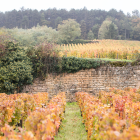The region of Burgundy may be small, but its influence on the world of wine is enormous, on par with the likes of Bordeaux in terms of global reputation and home to some of the most expensive wines on the planet.
Much of its success in winemaking can be attributed to its prehistoric positioning. Some 200 million years ago the region was part of a vast, tropical sea that gave rise to rich limestone soils – it’s these that are responsible for the zesty minerality that Burgundy’s wines are famed for. Winemaking itself in the area dates back to the Romans in the 1st century AD, but it wasn’t until the Middle Ages that it was more formerly established, in this case by Catholic monks who grew grapes for the church and local aristocrats.
Like any wine-producing region, a variety of grapes are grown here, however Burgundy is principally known for just two: Pinot Noir (red) and Chardonnay (white). More than half (some 51%) of the area’s vineyards are given over to Chardonnay, with Pinot Noir accounting for 40%. Winemakers in Burgundy are devoutly faithful to purity of expression, and so a Pinot Noir from Burgundy will contain nothing but Pinot Noir grapes, with the same rule applicable to Chardonnay.
In Burgundy, the unique combination of climate, land, and tradition – in other words, its terroir – means its wines are coveted by many and can never truly be replicated anywhere else.
Burgundy’s Pinot Noir
Burgundy’s greatest Pinot Noirs hail largely from the east and south-east-facing limestone hills of the Côte d'Or.
The Pinot Noir grape is one of the most fragrant in the world, yielding a variety of scented aromas based on red berry characters such as raspberry and strawberry, although hints of incense, cola-like spice and even mintiness are not uncommon.
While they do not have the aging potential of say, Cabernet Sauvignon or a great Merlot, Burgundy’s Pinot Noirs can do exceptionally well at eight or ten years – in many cases more. It takes very well to French oak and in bottle develops silky textures and attractive undertones of truffle, leather and game.
Curiously, the juice of the Pinot Noir grape is entirely colourless – it’s only during maceration and its time in the fermentation tank that the colourant within the skin of the grapes comes alive to give the wine its rich red colour.
But it’s a thin-skinned grape and notoriously temperamental, making it difficult to grow in climates and soils unlike those in Burgundy. However, that hasn’t stopped avid Pinot Noir fans outside the region from trying. Oregon in America’s Pacific north-west has a strong reputation for cool-climate Pinot Noir, while places in California, Chile, Argentina and Australia have also had success with the grape. New Zealand has long claimed to make the best Pinot Noir outside of Burgundy, and while it is certainly true that the island nation offers many fine examples – particularly from the likes of Marlborough and Nelson – Pinot Noir purists will maintain that the grape and its wines will always hail best from the famous French region.
Burgundy’s Chardonnay
While Chardonnay may well be the most popular of all grape varieties, Chardonnay from Burgundy is something else altogether. Described as the ‘Helen of Troy’ of Chardonnay, any producer that has ever encountered this grape knows that Burgundy sets the gold standard in this field.
Unlike Pinot Noir, however, its excellence lies largely in its immense versatility. Chardonnays from Burgundy’s Chablis are often minerally, those hailing from Meursault (Cote de Beaune), Chassagne and Puligny-Montrachet are complex and nutty, while grapes from the southern Pouilly-Fuisse lend themselves to riper and juicier outcomes.
And it boasts significant commercial benefits, too. The grapes grow easily, productively and profitably, and they respond well to a variety of winemaking techniques. It’s little surprise, then, that while Chardonnay vineyards are not as prevalent as the likes of Spain’s Airen or Italy’s Trebbiano, it is more widely distributed than any other variety. And its creation serves as something of a rite of passage for new wine producers – if you’re in the business of Chardonnay, it has to be excellent.
And that’s what sets Burgundy’s Chardonnays apart from those made in other regions. While the likes of California, Australia and South Africa offer up brilliant, opulently-flavoured Chardonnays of tremendous quality, the truly exceptional can only be found within the prestigious French region. There is, after all, a reason why New World winemakers will go to great lengths to mimic Burgundy’s specific techniques when it comes to fermentation and maturation.
And yet, despite this widely acknowledged ‘Burgundy style’, Chardonnay grapes from the region offer up a transparent medium through which different vineyards can communicate their own individual and highly-lauded styles – and that is truly the essence of terroir.
Burgundy Wine Investment Guide 2020
The Cult Wines investment team discuss the differences between the top and mid tier Burgundy wines in this years Burgundy Wine Investment Report.






